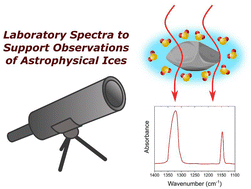A systematic mid-infrared spectroscopic study of thermally processed SO2 ices
Abstract
The use of mid-infrared spectroscopy to characterise the chemistry of icy interstellar and Solar System environments will be exploited in the near future to better understand the chemical processes and molecular inventories in various astronomical environments. This is, in part, due to observational work made possible by the recently launched James Webb Space Telescope as well as forthcoming missions to the outer Solar System that will observe in the mid-infrared spectroscopic region (e.g., the Jupiter Icy Moons Explorer and the Europa Clipper missions). However, such spectroscopic characterisations are crucially reliant upon the generation of laboratory data for comparative purposes. In this paper, we present an extensive mid-infrared characterisation of SO2 ice condensed at several cryogenic temperatures between 20 and 100 K and thermally annealed to sublimation in an ultrahigh-vacuum system. Our results are anticipated to be useful in confirming the detection (and possibly thermal history) of SO2 on various Solar System bodies, such as Ceres and the icy Galilean moons of Jupiter, as well as in interstellar icy grain mantles.



 Please wait while we load your content...
Please wait while we load your content...